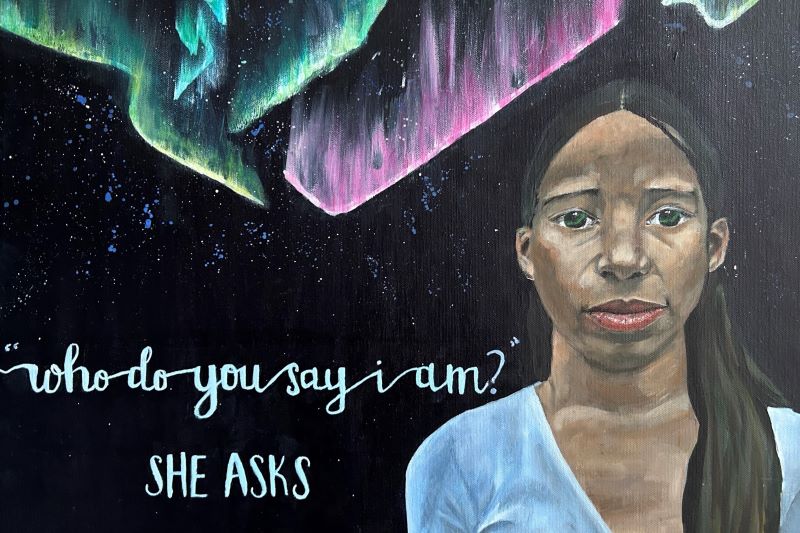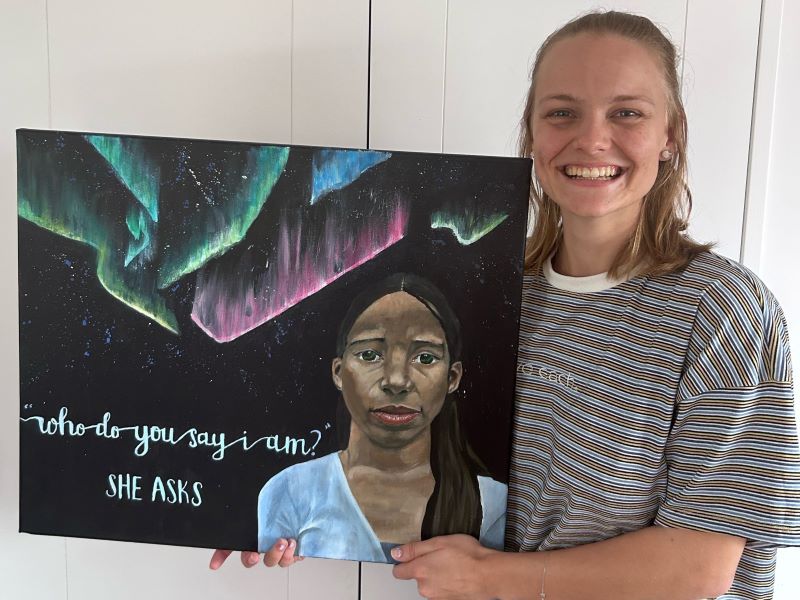Integrative Project: Grace Doak
In the final year of our Bachelor of Applied Theology, students build a capstone research project, where they integrate the various modes of learning that they have gained. Student Grace Doak painted and wrote about the predominance of masculine language used for God, and how that has affected the way that people perceive God. Her work is a challenge to consider how we speak of God, contemplate what pronouns we use, and consider the addition of feminine pronouns in our language used for God. “Just as belief informs language, language also informs belief.”
“A Spirit breathed understanding of God can be illustrated as a vast array of lights, some overlapping and combining, not restricted to one trait but encompassing the whole identity of the God who says, “I am who I am.” (Exodus 3:14)

At the beginning of my project, as I was researching and reflecting on the context of the exclusive use of male pronouns used for God, it became apparent to me that the core issue behind this was the way in which people perceive God.[1] Language used to refer to God reflects the way in which a person understands who God is.
I have created an artwork that is derived from my learnings so far. In the foreground, I have painted a woman, representing God. Throughout my research, I have come to believe that though the Fatherhood of God is an important[2] metaphor for understanding a believer’s standing with God, it does not necessitate God’s maleness.[3] She is both feminine, masculine, and a genderless spirit. A human framework of understanding identity cannot fully comprehend all that God encompasses in their identity. To reflect where I have landed theologically, I have painted the Northern lights. I would compare a human understanding of God’s identity to illustrating God as a white light. People struggle to understand God as more than one human trait which leads to issues like only using male pronouns for God, and in one sense putting God in a box fit for humanity. A Spirit breathed understanding of God can be illustrated as a vast array of lights, some overlapping and combining, not restricted to one trait but encompassing the whole identity of the God who says, “I am who I am.” (Exodus 3:14) I have painted one colour of the Northern lights in the woman’s eyes to portray the message that though God’s whole identity is not a woman, part of God’s vast identity is feminine.
An aspect of my response to the issue was to draw a response from the viewer. Part of this response is a reflection on imago Dei. One of the issues that is birthed out of the exclusive use of male pronouns in reference to God is that it affects women’s relatedness to God negatively. Portraying God as a woman provokes men to see the image of God fully in women and also for women to see themselves in God.
Though the question she asks are originally Jesus’ words to his disciples, I have posed the question from God to the viewer. This question touches on the concept of imago Dei again and challenges how a person understands God in partnership with the way God is illustrated as a woman. The woman being in the foreground and the focus of the portrait reflects my critique from the United Methodist’s response to the issue. I believe we need the feminine aspect of God’s identity to be the focus as we delve into the question of who we think God is, and challenge who we thought she was.
The feminine pronouns in the painting pushes for the addition of feminine pronouns to our language used for God. Just as belief informs language, language also informs belief.

[1] Premier Christian News, Most Brittish Christians believe God does not have a human gender identity, https://premierchristian.news/en/news/article/most-british-christians-believe-god-does-not-have-a-human-gender-identity
[2] Ronald W. Pierce, Rebecca Merrill Groothuis, and Gordon D. Fee, Discovering Biblical Equality
[3] Amy L. B. Peele, Women and the Gender of God, (Grand Rapids, Michigan: William B. Eerdmans Publishing Company, 2022), 15.
0 Comments